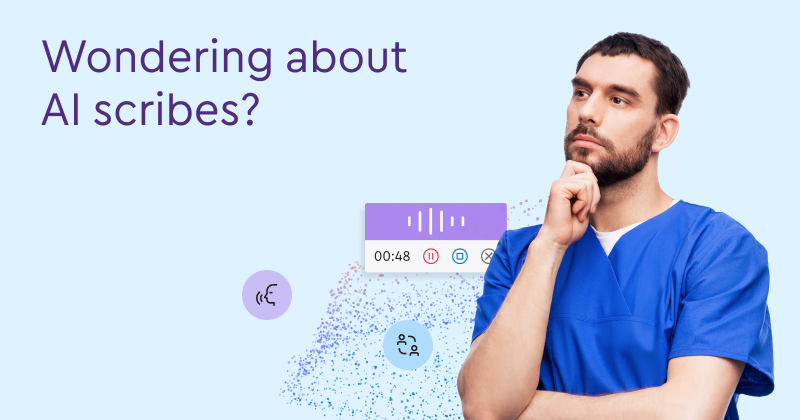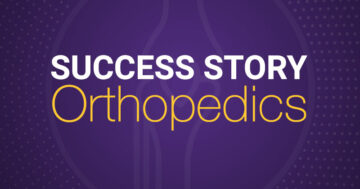Skeptical About AI Medical Scribes? 5 Answers to Commonly Asked Questions

If you’re curious about this new technology, you’re not alone
With all the noise surrounding AI innovations in healthcare, it can be tough to sort through the hype and find concrete answers. Here are answers to some of our most commonly asked questions about using an AI medical scribe tool, like ModMed® Scribe, in a clinical setting.
Q: Can an AI scribe understand my specialty’s medical terminology?
A: Yes, some can.
Although not every AI scribe tool is trained to recognize specialty-specific vocabulary, some are. For example, software developers can incorporate recognition of specific drug names in fine-tuning the software.1
Specifically, in the case of ModMed Scribe, it was built using specialty-specific encounter data in consultation with practicing physician specialists to help it more accurately capture specialty terminology and clinical services.
Q: Do my patients need to sign a consent form for an AI scribe to be used in the exam room?
A: It depends.
Informed consent is a cornerstone of medical treatment, and AI tools are no exception. The American Medical Association has stated that using an AI tool at any point in the care process requires informed consent to promote trust and transparency in the doctor-patient relationship.2 In addition, state laws applicable to your practice may require written consent or specific consent from the patient before using AI tools or recording patient-provider conversations. However, some practices may not be required to obtain specific patient consent.
ModMed does not advise practices on compliance and consent obligations with patients. ModMed Scribe requires users to confirm compliance with applicable law before enabling the tool’s recording feature. Practices are encouraged to consult with legal or compliance advisors regarding their specific use cases and workflows.
Q: Will the AI scribe always be listening?
A: Not if you use ModMed.
When you use ModMed Scribe, you must hit the record button for the AI technology to start listening in the exam room. You should begin recording at the start of the visit, before any clinical conversations take place, but you control when the recording starts. If you click out of the patient’s chart or go to the home screen, the recording stops and autosaves. However, you can navigate anywhere within the same patient’s chart while the recording is processing in the background.
Q: Do AI medical scribes have the ability to learn?
A: Yes.
In general, AI scribe tools can make predictions based on patterns they’ve been trained to recognize. These patterns are encoded into the software in the form of an algorithm. Then, the information can be ranked in order of importance by human annotators. This is how some AI tools learn to produce meaningful summaries based on a large volume of audio recordings, past examples of medical notes, and data sets.3 AI medical scribes can manage a higher volume of language data much faster than an average human being,4 and can filter out extraneous information to help produce a clinically meaningful note.5
In the case of ModMed Scribe, the AI has been trained on a repository of millions of structured parameters from sampled de-identified patient records to make predictions. ModMed Scribe learns over time because our doctors and programmers retrain the model and use algorithms to improve the model’s response to new terminology.
Q: Will I have to spend time manually correcting notes from AI scribes?
A: Yes, but …
Conversational speech processing can be vulnerable to error due to how unstructured our natural human language is when it’s used, as well as the complexity of the clinical environment.6 Consider that substituting nonverbal sounds, such as “uh-uh” for the word “no,” may not be able to be consistently recognized or transcribed by AI language models.7 This is why human review remains necessary; the nonverbal context happening in the exam room can be key in the treatment process.
But, there is a way to capture this context more accurately with an AI medical scribe. When discussing diagnoses, morphologies, exam findings, plans, body locations, and surgical, imaging or lab orders, you can verbalize the details you want the AI to capture. These speech habits can be easily learned in training sessions to help reduce manual review time.
Key takeaways
AI medical scribes can be a powerful tool to help you document clinical notes more efficiently, including by understanding the nuances of your specialty and learning over time. While clinician review is imperative in order to accurately capture visit information, you can feel more confident using this technology when you’ve learned about some of these key areas.
1 “AI Scribes for Clinicians: How Ambient Listening in Medicine Works and Future AI Use Cases.” AMA Update. Jan 6, 2025.
2 “How Physicians Can Ethically Utilize Artificial Intelligence in the Medical Field.” AMA Ed Hub. Mar 7, 2024.
3 Kuzub, Alena. “How Will AI Scribes Affect the Quality of Health Care?” Northeastern Global News. Dec 5, 2024.
4 Lubell, Jennifer. “Never Terse, Always On: How AI Helps Clear Doctors’ EHR Inboxes.” AMA News Wire. Apr 8, 2024.
5 Robeznieks, Andis. “AI Scribe Saves Doctors an Hour at the Keyboard Every Day.” AMA. Mar 18, 2024.
6 Quiroz, Juan C., et al. “Challenges of Developing a Digital Scribe to Reduce Clinical Documentation Burden.” NPJ Digit Med. National Library of Medicine. Nov 22, 2019.
7 Tran, Brian D., et al. “Mm-hm,” “Uh-uh”: Are Non-Lexical Conversational Sounds Deal Breakers for the Ambient Clinical Documentation Technology?” Journal of the American Medical Informatics Association. Jan 23, 2023.
This blog is intended for informational purposes only and does not constitute legal or medical advice. Please consult with your legal counsel and other qualified advisors to ensure compliance with applicable laws, regulations, and standards.







